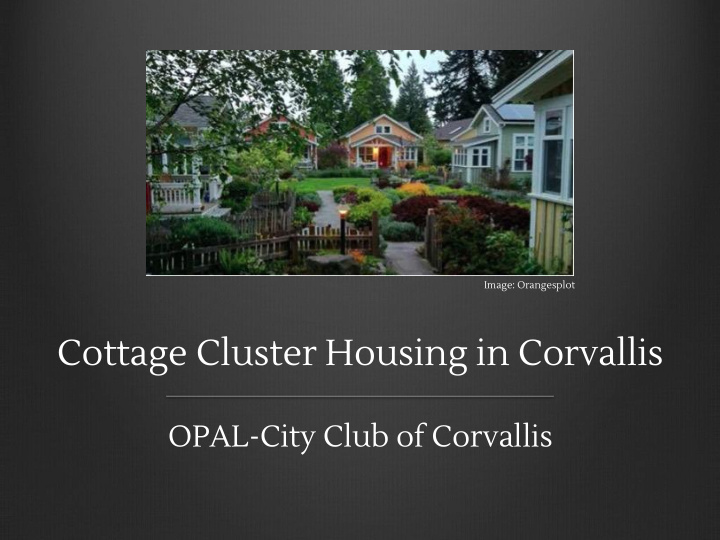



Image: Orangesplot Cottage Cluster Housing in Corvallis OPAL-City Club of Corvallis
Background • Who? Corvallis City Club and OSU Policy Analysis Lab (OPAL) • What? Working together to investigate opportunities and/or barriers to Cottage Cluster Housing (CCH) • When? OPAL Housing Team has been researching this topic since September 2017 • Why? Corvallis has land development code (LDC) language in place to allow for CCH development, but few projects have been proposed thus far.
Corvallis Housing Challenges • A study conducted by EcoNorthwest in 2014 identified some key problems with housing in Corvallis: • Low supply and high demand, where land availability does not meet housing development needs • Price increases and lack of incentive to develop high-density • 18,000 people commute into Corvallis each day for work - 76% identified housing cost as a barrier to living in Corvallis • Additional air pollution and traffic from an increased number of commuters to and from Corvallis each day, particularly along HWY 99 & 20 • Diverse population needs hinder the ability to address the problem through a “one type fits all” approach
Methods • Content Analysis: literature, websites, and reports • Interviews: 13 total • Developers • City Employees • Local Government Officials (e.g., Gresham, Adair Village, etc.) • Nonprofits • GIS Analysis: residential zone density, annexed land, future development sites
Interviews Main themes: • Limited land available for residential use hinders CCH development • Differences in profitability opportunities for CCH compared to single family housing • LDC are complicated and approval for housing projects are time consuming • Successful CCH communities have niche residents and focus on walkability • CCH can increase housing supply, but Corvallis needs to also address the impact of OSU students on the housing market
Cottage Cluster Housing • Cottage Cluster housing (CCH) developments are a specific type of plan to maximize housing density on a lot while providing single-family homes (usually under or around 1000 sq. ft.) with a shared outdoor common area. Houses generally have a small yard and a covered porch. Image: The Cottage Company
Typical Characteristics of CCH DEQ, 2016
Missing Middle Cottage Cluster can be missing middle but missing middle is not always cluster cottage Image: http://missingmiddlehousing.com/
City of Adair Village • Proposed Cottage Cluster development is on 5 acres near wetlands and farmland • Development is outside the UGB • Barriers to the project include complicated requirements, time intensive approval process, and high expenses • Community opposition
Corvallis Cottage Cluster Housing Cottage cluster houses on the corner of NW Tyler and NW 10th, Corvallis
Corvallis Cottage Cluster Housing Cottage cluster houses on the corner of NW Harrison and NW 14th, Corvallis
Supportive Policies Key Element: Concise definition of cottage cluster dwelling • Corvallis LDC does not feature concise CCH definition • Nevertheless, Corvallis LDC does permit CCH development 1. Cottage Cluster housing is allowed under LDC RS5, RS6, RS9, and RS12. 2. Under each of these LDCs specifications regarding units/acre are in effect (ex. RS5 & RS6 minimum 2/acre, maximum 6/acre, RS 9 minimum 6/acre, maximum 12/acre, RS12 /acre)
Residential Zoning
Barriers to CCH Development Four Primary Barriers: LDC 1 Ambiguous CCH Language ➔ Language Corvallis City Charter - Vote by ➔ Limited Annexation 2 Land Supply State/County Land-Use Laws ➔ Community Urban/Rural Classification ➔ 3 Dynamics Increased OSU Enrollment ➔ Developer Monetary Expenses ➔ 4 Costs Time Intensive Process ➔
Policy Recommendations ➔ Introduce Development Incentives ➔ Streamline Development Process ➔ Create CCH Specific Residential Zones ➔ Expand City Limits through Annexation ➔ Boost Community Support
Corvallis Potential • CCH is generally low on the housing priority for developers, would need to consider incentivizing (through density bonuses, etc.) to encourage or at least defray some of the building and investment costs. • Consider changing some of the LDCs to specifically address cluster/cottage housing, particularly in “odd” shaped land parcels could zone to encourage cluster/cottage housing. • Will not necessarily create affordable housing, and will be less likely to provide high density for college students, young families, etc. like apartments.
Potential Site Development
Basic Housing Needs • Land supply extremely difficult to come by. • People need affordable, available housing. • Cottage cluster is one element, but really about infill for a specific type of lifestyle housing communities. Overall, housing should offer variety and affordability. • Because of the cottage cluster lifestyle, the demand may off-set affordability (ex. In Chapin’s Third Street Cottages, resale prices were 250% above initial purchase price).
Questions? Images: Ross Chapin Architects
Flag Lots
Recommend
More recommend